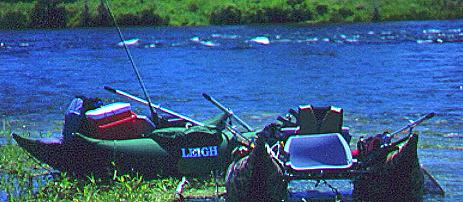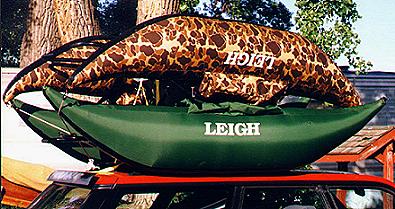|
Castwell and I are off fishing our "home waters" in Michigan this week,
Al Campbell noticed a posting to our Guest Book asking about float tubes
and personal watercraft. So here is Al, answering the request and filling in
for the Ladyfisher. Thanks Al!
One of the fastest growing sports in America is float tubing.
It seems that much of the popularity of this sport is due to the low cost
and maneuverability of this type of water craft. People are using float
tubes for fishing, duck hunting and photography as well as just relaxing
on the water. With this rapid growth in popularity, many companies are
moving fast to cash in on the sport with mixed results for the consumer.
Because of this rapid expansion in companies offering
float tubes, it has become very difficult to choose the right tube for the sport
you intend to pursue. The choices you make in selecting a float tube could be the
difference between hours of fun or moments of terror. The consumer,
armed with a good understanding of float tube basics, has a much better
chance of making the right choices while selecting his or her
equipment.
Float tubes are basically an inner tube or bladder
with a nylon or canvas cover and a seat that's attached to this cover.
Sounds simple doesn't it? It's a little more complex than that. Shape,
size and methods of manufacture determine the safety and stability of
any float tube. Color and design determine the uses of this water craft.
I'll try to answer some of the questions I've been asked and maybe it
will help you select the right float tube for your sport.
"Why is shape important?" The shape and size
of a float tube determines its stability in the water. The larger the float
tube and the broader its stance in the water, the more stable it will be.
A float tube with a 22 inch inner tube will be more stable than one with
a 20 inch inner tube, etc . . . Although float tubes seldom tip over in the
water, this is a very real concern. A broader float tube, (pear shaped),
with extra floatation behind the seat is much more stable than a round tube
and less likely to tip over in rough water. This could be extremely important
in water shared with power boats.
Extra floatation also creates greater stability. If you
weigh 200 pounds, a float tube with 350 pounds of floatation will be twice as
stable as one with 250 pounds of floatation. Simply put, bigger bobbers
float higher than little bobbers. One problem is that there is no real
standard in the industry to compare tubes with. One company's 350 pound
tube might only float as much as another company's 275 pound tube.
The key here is to shop with companies that have
been in the business for a long time and have established a reputation for
building quality products. My own observation is that companies who do
most of their business by mail order have lower floatation properties compared to
companies who do most of their business through "pro shops". Ideally the
tube you select should float you and your gear with more than half of the
tube remaining above the water line.
"How do I determine the right design for my needs?" Design is
important. Some float tubes have open fronts while others are round.
Some come with more cargo pockets than others. Most have some kind of
apron to cover the lap of the float tuber. Some are pontoon designs with
a seat suspended between two floatation chambers. Budget and needs will
ultimately determine the best choice here.
Round designs are the least costly and as a result,
the most popular. Open front tubes and pontoon style tubes are easier
to get in and out of. They are generally more stable than round tubes and
usually cost more.
"U" shaped float tubes generally have a light weight
bladder that is used for floatation instead of the inner tube used in most
round tubes so they usually weigh less. This design can be carried into
the water before sitting down so the chances of falling while carrying your
tube are reduced. One potential draw back is that the front is open and
you could slip out the front, although this is unlikely since the seat design
cradles the rider toward the back of the seat.
Pontoon designs have a seat suspended between
the pontoons. Since the seat is out of the water, you ride higher and farther
out of the water. This is more comfortable in cold water but can be a
drawback in the wind since your body acts like a sail when it's farther
out of the water. Pontoon designs are generally the most comfortable
and cost the most to manufacture. Some are even set up for trolling
motors and oars. Especially good if you have physical problems.
If your budget will allow, the pontoon design is the most stable and
comfortableof them all. Of all the designs, it also has the most
accessories available. Like open front tubes, this design can
be carried into the water before getting into it so it's safer from the
stand point of entering the water.

If you are going to be using your float tube in
moving water, make sure it is a pontoon style. Round and U-shaped float
tubes are unsafe in moving water, and you could end up on the front
page of the local paper as the one who drowned while floating the
river in one. Many companies offer pontoon style float tubes that
were designed for moving water. If you are going to be using it in
moving water, get one of these. Transportation of pontoon boats
can be a slight problem though.

Some pontoon styles use rigid tubes made of plastic.
While these types don't need inflation, they often don't maneuver well in
moving water because of the straight style pontoons they employ. Rigid
pontoons don't bounce off rocks as well as inflatables do either. Why do
you suppose they use rubber rafts on the Colorado river insead of rigid boats?
In moving water, use an inflatable pontoon boat.
Extra cargo pockets allow you to carry extra gear.
Whether it's fishing tackle, camera gear or extra shotgun shells for the
duck hunter, this is a nice feature that will enhance the usefulness of your
float tube. It's easy to run out of room in the cargo pockets so spend a
little extra to get plenty of cargo room.
"Why is color important?" For the duck hunter
or photographer, camouflage is important if you're going to be able to
approach your subject without scaring it away. If you're sharing the
water with power boats, bright colors are important to keep you from
being run over by a speed boat. The better companies include a
fluorescent orange panel on the back rest of their float tubes for
increased visibility in the water.
"Is the fabric of the cover very important?" Yes,
the fabric that the tube cover is made of is very important. Weak fabric
can tear easily resulting in a potentially dangerous swim in the lake. It's
always best to select a float tube with a lifetime warranty on the fabric to
reduce the chances of getting one that will fall apart when you need it most.
Make sure that the fabric is nylon so it won't rot and fail in rough
water.
Another important factor is product liability insurance.
The best companies carry several million dollars worth of product liability
insurance. I wouldn't ride in a float tube that wasn't covered by this
kind of liability protection for two reasons. First, if they don't have
the insurance, they probably don't have a quality product either.
Second, if the unthinkable should happen, I want to know that the company
that produced the product will stand behind it with me or my family to
cover medical bills or, (God forbid), the funeral and income expenses
should their error cost my life.
Last and possibly the most important, no one should
ever enter the water in a float tube or any other water craft without a
personal floatationdevice (PFD). Should your float tube sink or tip over,
a PFD could save your life. With so many styles of PFDs to choose from,
it's easy to find one that fits and will work for your needs. Never, never
enter the water without a PFD! (In some states it's the law!) It's also a
good idea to always have a partner floating with you in case you get into
trouble on the water. Use the buddy system, it works!
Float tubing is a fast growing sport. It can be relaxing
and give you access to areas that are inaccessible to a boat or wading. If
you decide to give it a try, choose the best equipment you can afford for greater
safety and enjoyment. ~Al Campbell
|









